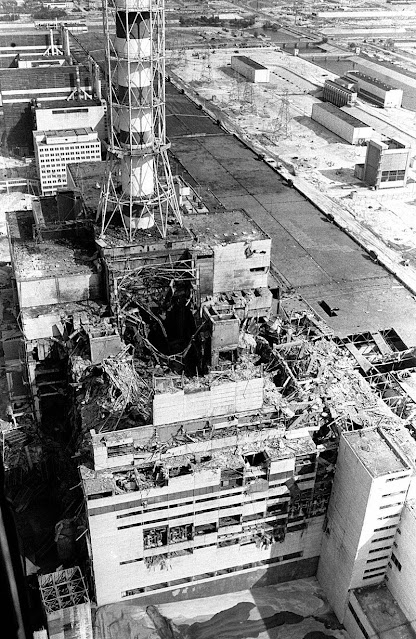----------ooOoo----------
By the way:
How do people like the On This Day posts?
----------ooOoo----------
April 26, 1986
World's worst nuclear disaster, Chernobyl
Reactor 4 several months after the disaster. Reactor 3 can be seen behind the ventilation stack, Reactors 1 and 2 in the background.
On April 26, 1986, the No. 4 reactor of the Chernobyl Nuclear Power Plant, located in Soviet Russia and what is now the Ukraine, exploded. With dozens of direct casualties, it is one of only two nuclear energy accidents rated at the maximum severity on the International Nuclear Event Scale, the other being the 2011 Fukushima nuclear accident.
International Nuclear Event Scale
The response involved more than 500,000 personnel and cost an estimated 18 billion rubles (about $84.5 billion USD in 2025). It remains the worst nuclear disaster in history, and the costliest disaster in human history, with an estimated cost of $700 billion USD.
The disaster occurred while running a test to simulate cooling the reactor during an accident in blackout conditions. The operators carried out the test despite an accidental drop in reactor power, and due to a design issue, attempting to shut down the reactor in those conditions resulted in a dramatic power surge. The reactor components ruptured and lost coolants, and the resulting steam explosions and meltdown destroyed the Reactor building no. 4, followed by a reactor core fire that spread radioactive contaminants across the Soviet Union and Europe.
A 10-kilometre (6.2 mi) exclusion zone was established 36 hours after the accident, initially evacuating around 49,000 people. The exclusion zone was later expanded to 30 kilometres (19 mi), resulting in the evacuation of approximately 68,000 more people.
Following the explosion, which killed two engineers and severely burned two others, an emergency operation began to put out the fires and stabilise the reactor. Of the 237 workers hospitalized, 134 showed symptoms of acute radiation syndrome (ARS); 28 of them died within three months. Over the next decade, 14 more workers (nine of whom had ARS) died of various causes mostly unrelated to radiation exposure. It is the only instance in commercial nuclear power history where radiation-related fatalities occurred. As of 2005, 6000 cases of childhood thyroid cancer occurred within the affected populations, "a large fraction" being attributed to the disaster. The United Nations Scientific Committee on the Effects of Atomic Radiation estimates fewer than 100 deaths have resulted from the fallout. Predictions of the eventual total death toll vary; a 2006 World Health Organisation study projected 9,000 cancer-related fatalities in Ukraine, Belarus, and Russia.
----------ooOoo----------



No comments:
Post a Comment
Note: Only a member of this blog may post a comment.